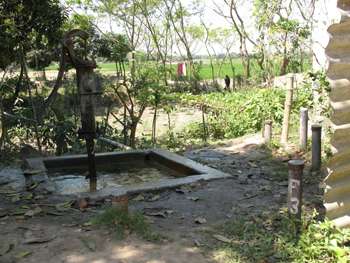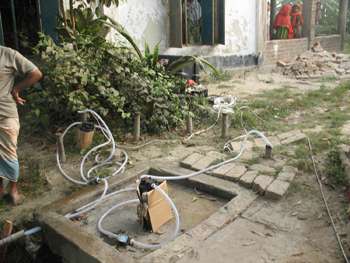It's only natural: Researchers find link to arsenic-contaminated groundwater

(Phys.org) —Human activities are not the primary cause of arsenic found in groundwater in Bangladesh.
Instead, a team of researchers from Lawrence Livermore National Laboratory, Barnard College, Columbia University, University of Dhaka, Desert Research Institute and University of Tennessee found that the arsenic in groundwater in the region is part of a natural process that predates any recent human interaction, such as intensive pumping.
The results appear in the March 4 edition of the Proceedings of the National Academy of Sciences.
Millions of people in Bangladesh and neighboring countries are chronically exposed to arsenic-contaminated groundwater, which causes skin lesions and increases the risk of certain cancers. Bacterial respiration of organic carbon releases naturally-occurring arsenic from sediment into groundwater, but the source of this organic carbon remains unclear.

Brian Mailloux of Barnard College and his team isolated microbial DNA from several depth intervals in arsenic-contaminated aquifers in Bangladesh and analyzed the DNA's radiocarbon signature, which reflects whether the organic carbon used by the microbes derives primarily from younger, surface-derived sources that are transported by groundwater into the aquifers, or older, sediment-derived sources.
Using "bomb pulse" radiocarbon analysis, Lawrence Livermore scientist Bruce Buchholz dated the DNA of groundwater bacteria. He found that the DNA samples were consistently younger than the sediment, suggesting that the microbes favor using surface-derived carbon.
The surface-derived carbon has flowed into the aquifer over hundreds to thousands of years—a rate that is approximately 100 times slower than groundwater flow. The results suggest that recent human activities, such as intensive groundwater pumping, have not yet significantly affected the release of arsenic into the groundwater at this site.
Above-ground testing of nuclear weapons during the Cold War (1955-1963) caused a surge in global levels of carbon-14 (14C), and remains in all living things. Carbon-14 or radiocarbon is naturally produced by cosmic ray interactions with air and is present at low levels in the atmosphere and food. Although nuclear weapon testing was conducted at only a few locations, excess levels of 14C in the atmosphere rapidly dispersed and equalized around the globe.
According to Buchholz, "The bomb curve forms a chronometer of the past 60 years."
The radiocarbon signature of DNA is a direct measure of the carbon used during microbial respiration and growth. In this study, the team developed a method to filter, extract and purify DNA from groundwater aquifers for radiocarbon analysis to determine the organic carbon pools fueling microbial reduction.
"We were able to separate the recent bomb pulse radiocarbon from the natural carbon signature and found the arsenic levels are now directly tied to a natural process as opposed to being driven by human activities," Buchholz said.
The results may help scientists understand the causes of arsenic contamination in the region, and the development of potential mitigation strategies.
More information: "Advection of surface-derived organic carbon fuels microbial reduction in Bangladesh groundwater," by Brian J. Mailloux et al. PNAS, 2013.
Journal information: Proceedings of the National Academy of Sciences
Provided by Lawrence Livermore National Laboratory




















